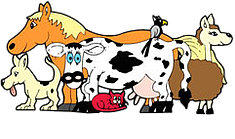Routine Laboratory Tests for Cats and Dogs 1
 Regular routine check-ups for our pets can often lead to a longer, trouble free life since they can frequently give an early indication of impending problems. These check-ups usually take place at the time of the annual booster vaccination. As the need for revaccination grows less each year due to improved vaccines, the need for routine annual check-ups should not be forgotten, particularly in the case of older animals, even if, to all intents and purposes the pet appears to be perfectly healthy.
Regular routine check-ups for our pets can often lead to a longer, trouble free life since they can frequently give an early indication of impending problems. These check-ups usually take place at the time of the annual booster vaccination. As the need for revaccination grows less each year due to improved vaccines, the need for routine annual check-ups should not be forgotten, particularly in the case of older animals, even if, to all intents and purposes the pet appears to be perfectly healthy.
What is involved?
Initially a careful history is taken. Be sure to mention anything you have noticed, i.e. change in behaviour, increased thirst, urination, etc. A routine physical examination then follows. A blood sample can usually be obtained at this time together with a urine sample. Sometimes we may ask you to bring in samples of both urine and faeces. At the same time we can administer a booster vaccination if required.
 What are the samples tested for?
What are the samples tested for?
- Routine blood tests include a complete blood count (CBC) together with a biochemistry profile. These tests will give an indication of possible anaemia, infection, liver and kidney problems, etc.
- A faeces sample will indicate the presence of intestinal roundworms, tapeworms or other endoparasites and also give an indication of the state of digestion.
- A urine sample will often give an indication of the onset of kidney or liver problems and also diabetes mellitus (sugar diabetes). These are problems which are not uncommon in the older pet.
- Bile acid tests usually involve separate blood samples. Bile acids are manufactured by the liver, stored in the gall bladder and are important in the digestion of fats. Their basic function is to break down large fat molecules into smaller particles that are more easily absorbed into the bloodstream. During this process they are not themselves digested but are absorbed with the digested fats into the bloodstream and returned to the liver where they are extracted and returned once more to the gall bladder. A sample is taken from the fasted animal and then two hours after a meal. The results are then compared. If the liver is working normally the two bile acid results will be very similar indicating that the liver and its blood supply are within normal limits. Abnormal results may indicate the need for further testing in order to determine the cause. Problems with digestion are not uncommon in older cats and dogs. If caught in time, minor attention to diet is frequently all that is necessary in the first instance.
- Depending on the history and physical examination sometimes routine thyroid tests are also carried out, particularly in the case of cats.
Why is this necessary?
The thyroid gland can be likened to the accelerator in a car. It sets the rate at which the whole body works. The most common thyroid disease in the dog is hypothyroidism, a "lazy thyroid" due to too little thyroid hormone being produced. This can cause obesity, lassitude and skin changes.
 In the cat hyperthyroidism is relatively common. With this condition too much thyroid hormone is produced. This often results in a nervous excitable cat which eats ravenously and does not put on weight. Tests will often reveal the early onset of these problems and appropriate treatment can then be administered.
In the cat hyperthyroidism is relatively common. With this condition too much thyroid hormone is produced. This often results in a nervous excitable cat which eats ravenously and does not put on weight. Tests will often reveal the early onset of these problems and appropriate treatment can then be administered.
How do I obtain the faeces and urine samples?
We will supply you with appropriate containers and instructions. If you have difficulties do not hesitate to let us know, we appreciate that some cats and dogs resent interference with their toileting! If you are unsuccessful we will admit your pet for a few hours in order to obtain a sample.
What happens next?
Once we have obtained the results we will discuss these with you and, where appropriate, supply further handouts.
© Copyright 2025 LifeLearn Inc. Used and/or modified with permission under license. This content written by LifeLearn Animal Health (LifeLearn Inc.) is licensed to this practice for the personal use of our clients. Any copying, printing or further distribution is prohibited without the express written consent of LifeLearn. This content does not contain all available information for any referenced medications and has not been reviewed by the FDA Center for Veterinary Medicine, or Health Canada Veterinary Drugs Directorate. This content may help answer commonly asked questions, but is not a substitute for medical advice, or a proper consultation and/or clinical examination of your pet by a veterinarian. Please contact your veterinarian if you have any questions or concerns about your pet’s health. Created on Jul 11, 2015.

